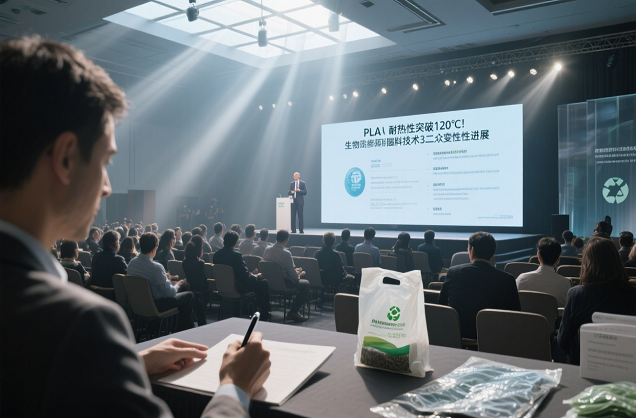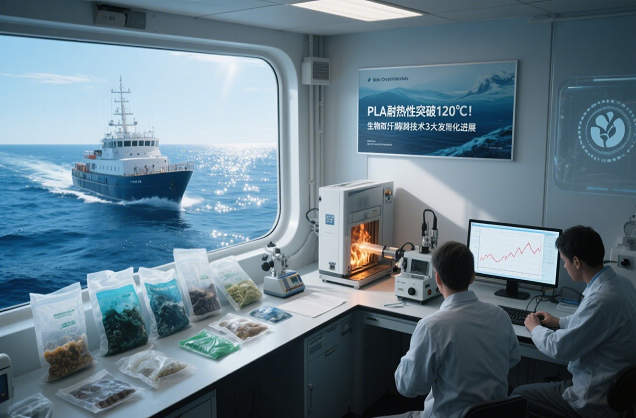PLA heat resistance exceeds 120°C! 3 Disruptive Advances in Biodegradable Film Technology
The year 2024 brings great news to the materials science community - Corbion, the world's leading bioplastics company, has successfully developed a fourth-generation PLA (polylactic acid) material that is heat-resistant up to 120 degrees Celsius, breaking through the technological bottleneck in high-temperature application scenarios for biodegradable films. This milestone progress enables PLA films to replace more than 90% of traditional petroleum-based plastic packaging.

I. Three major technological breakthroughs in heat-resistant PLA
1. Stereo composite core technology (breakthrough point 1)
Technical principle: through the precise pairing of levo-(PDLA) and dextro(PLLA) lactic acid molecules to form a high degree of stereocomposite crystals.
Key Data:
Heat distortion temperature increased from 60°C to 118°C
Crystallinity of 50% (ordinary PLA only 30%)
Microwave oven resistance test passed 1000 cycles
Application scenarios: hot drink cup lids, microwave food packaging, protective film for electronic components
2. Nanocellulose reinforced technology (Breakthrough point 2)
Innovative process:
Adopt cellulose nanowhiskers with 2-5nm diameter
Surface grafted PLA compatibilizer
Three-dimensional network structure enhancement
Performance enhancement:
Tensile strength 85MPa (close to PET film)
Thermal expansion coefficient reduced by 40%
Light transmittance maintained at 92% or more
Typical case: Toyota Boshoku Japan has been used in automobile interior parts.
3. Multi-component synergistic stabilization technology (breakthrough point 3)
Formulation system:
Organic rare earth heat stabilizer (0.3-0.5%)
Phosphate ester anti-hydrolysis agent
Vitamin E derivative antioxidant
Durability test:
Strength retention rate >95% after aging at 120℃/100h
5 times longer service life under hot and humid environment (85℃/85%RH)

II. Performance Comparison with Traditional Materials
Performance indicators Fourth-generation PLA Ordinary PLA PP plastic Comparison of advantages
Heat distortion temperature (℃) 118 55 105 First time to surpass polypropylene
Tensile strength (MPa) 85 60 35 Leading mechanical properties
Oxygen permeability (cc/m²-d) 120 150 2500 Freshness improvement by 2 times
Degradation time (months) 6-12 12-24 400+ Maintains degradable properties
Carbon Footprint (kgCO₂/kg) 1.8 2.0 3.5 Significant Environmental Advantages
III. Three major application areas to be subverted
1. High-temperature food packaging revolution
Ready-to-eat lunch box: 121 ℃ steam sterilization resistance, has been approved by the FDA food contact certification
Coffee capsules: Switzerland's Nespresso announced a full switch in 2025
Bakery packaging: resistant to oven 230 ℃ / 15 minutes of short-term heating
2. Expansion of applications in the electronics industry
Flexible Circuit Substrate: Reflow Resistance (260°C/10 sec) up to standard
Battery Separator: Controllable porosity (30-70%), excellent thermal shutdown characteristics.
Optical film: passed 2000 hours of high-temperature and high-humidity environment test.
3. Automotive parts innovation
Interior skin: high temperature resistance (110℃) without deformation of the instrument panel
Wiring harness packaging: UL94 V-0 flame retardant grade
Temporary protective film: easy to peel off after spraying and drying (80-100℃).

IV. Industry Chain Impact Analysis
1. Demand for equipment modification
Injection molding machine: temperature control system needs to be upgraded to 200°C
Mold: shrinkage rate adjusted to 1.2% (ordinary PLA is 1.8%)
Drying system: dew point requirement <-40℃ (waterproof sub-degradation)
2. Cost-effective calculation
Item Fourth generation PLA food grade PP Difference
Raw material cost ($/kg) 3.8 1.5 +153% - Advantages
Processing energy consumption 15% lower - Advantage
Recycling value Composting revenue Degraded recycling Advantage
Brand premium 20-30% - Significant

V. Technical Challenges and Solutions
1. Three existing bottlenecks
Narrow processing window: Melt strength is 30% lower than PP.
High raw material purity requirement: D-lactic acid content needs to be <0.5%.
Conflicting recycling systems: cannot be mixed with PET recycling streams.
2. Latest solutions
Specialized chain extender: BASF launched Joncryl ADR-4468 to improve melt strength.
Stereospecific catalyst: CAS develops new zinc complex to control isomer content
Digital Watermarking: HolyGrail 2.0 Project Automates Sorting
 Significant progress in PBAT/s
Significant progress in PBAT/s
 PLA/PBAT composite film degrad
PLA/PBAT composite film degrad
 A New Choice for Takeaway Pack
A New Choice for Takeaway Pack
 Significant progress in PBAT+s
Significant progress in PBAT+s
CONTACT
Add: Room 4006, No.1 Helong Yiheng Road, Baiyun District, Guangzhou City
Tel: +8613450255948
Wechat : +86-13450255948
Fax: +86-13450255948
E-mail: 13450255948@163.com








